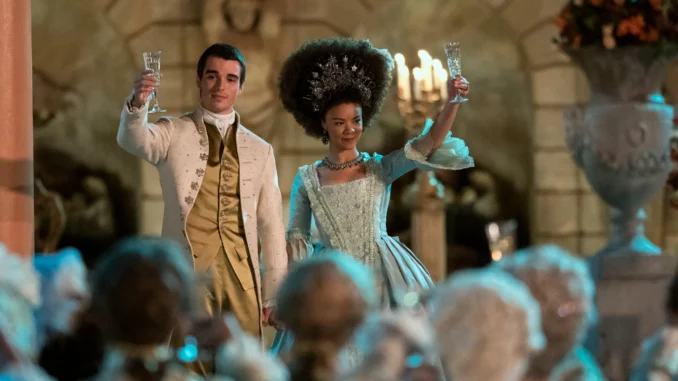
The show’s creator, Shonda Rhimes, and a few historians spoke about the facts, fantasy and controversy surrounding Netflix’s new prequel series to “Bridgerton.”
With her withering glares and colossal wigs, Queen Charlotte has become a treasured character in the first two seasons of “Bridgerton,” the steamy hit Netflix series set in an alternate, racially diverse version of Regency Era Britain. As played by Golda Rosheuvel, she is a hard-line matriarch with an ear for gossip and an eye for beauty.
Now she is the subject of her own six-episode Netflix prequel series, “Queen Charlotte: A Bridgerton Story,” which tells the tale of young Charlotte (India Amarteifio) as she begins her rise to power. Viewers witness her whirlwind marriage to King George III, meet her delinquent children and come to better understand her motivations and loneliness. They also get plenty of glimpses, of course, into the royal bedchamber.
“‘The love of Queen Charlotte and King George unites the nation’ — that’s one sentence in ‘Bridgerton,’ and to me that told a whole world,” Shonda Rhimes, the show’s creator, said in a phone interview last week. “We are telling the story of how their love unites the world in a very small way.”
In line with the franchise’s overall approach to diverse casting, the “Bridgerton” Charlotte is also presented as being of African and European heritage — though in her case, the decision was rooted partly in speculation by some historians that the real Charlotte was biracial, a subject of much debate.
But what do we know about the historical Charlotte? What are the terms of the debate? And is that debate beside the point for a story that Rhimes herself describes as fantasy? We spoke to Rhimes and several historians about the series, which has been Netflix’s most-watched show globally since it debuted last week.

Who was Charlotte?
The basic facts of Charlotte’s life are well documented: The real Princess Sophie Charlotte was born in 1744 in Mecklenberg-Strelitz, which is now part of Germany. At age 17, she married King George III, six hours after her arrival in London. The couple had their first child, George IV, in 1762, followed by 14 more children.
The first 25 years of their life together appear to have been happy and pleasurable. Together they played, hosted concerts and invited a young Mozart to perform for them in 1764. In 1788, King George III experienced a serious bout of mental illness, and his manic, violent behavior worsened over time. In 1811, his son George IV took over leadership duties as prince regent. George III was often kept isolated, and he and Charlotte led increasingly separate lives. She died in 1818; George III died two years later.
To these details the prequel is largely faithful. With others, the series takes unapologetic creative license — indeed, that license is central to its premise.
Since the start of the “Bridgerton” franchise, Rhimes and her team have worked from the idea, put forth by some historians, that Charlotte was a woman of mixed racial heritage, a descendant of a Black branch of the Portuguese Royal family. Many other historians disagree with that theory. But in developing the new series, Rhimes was less interested in the debate than in staying true to the world she had already created: a fictional story with historical elements, in which a Black Queen Charlotte, richly adorned in jewels and corseted gowns, ruled valiantly while caring for the king.
“It was allowed to really fantasize about telling the story of the character I was most interested by, and that was an easy jumping off point for me,” Rhimes said. “It’s not a history lesson. It’s really the story of the Queen Charlotte as we know her from ‘Bridgerton.’”
Wherefore the controversy?
The idea that the historical Charlotte might have been biracial, by way of a Black branch of the Portuguese royal lineage, was put forward prominently in 1997 by the historian Mario de Valdes y Cocom for PBS Frontline. But many historians have disputed that claim or argued that any potential African heritage would have been so removed as to be virtually untraceable.
Rhimes said she had no opinion on the real Queen Charlotte’s heritage, though she found it “interesting,” she said, “how vehemently people need to say that she’s not a person of color.” Arianne Chernock, a professor at Boston University who specializes in British and European history, argued that questions over Charlotte’s potential Blackness miss the point that Britishness, whatever the color, is not a fixed thing.
“We know that Queen Charlotte had Portuguese ancestry,” Chernock said. “She was a German princess, the daughter of a Duke,” she continued, noting that “when Charlotte arrived in Britain in 1761, she didn’t speak English.”
“To place this multicultural past within the family, it forces people to think about what Britishness is,” she added.
